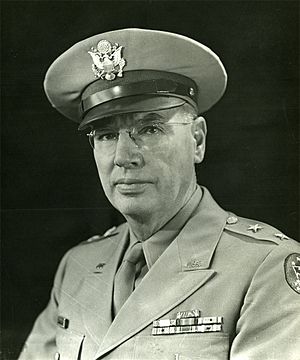George F. Moore (general) facts for kids
Quick facts for kids
George Fleming Moore
|
|
|---|---|

Major General George Fleming Moore
|
|
| Born | July 31, 1887 Austin, Texas |
| Died | December 2, 1949 (aged 62) Hillsborough, California |
| Buried |
Golden Gate National Cemetery, San Bruno, California
|
| Allegiance | |
| Service/ |
|
| Years of service | 1909–1949 |
| Rank | |
| Commands held | Harbor Defenses of Manila and Subic Bays |
| Battles/wars | World War I World War II |
| Awards | Distinguished Service Cross Distinguished Service Medal (2) |
George Fleming Moore (born July 31, 1887 – died December 2, 1949) was an important officer in the United States Army. He reached the rank of Major General. General Moore was in charge of the Harbor Defenses of Manila and Subic Bays and the Philippine Coast Artillery during a major battle in World War II, known as the Battle of Bataan.
Contents
Early Life and Education
George Fleming Moore was born in Austin, Texas, on July 31, 1887. His parents were John Marks Moore, Jr. and Mary Estelle Grace Moore. He went to A&M College of Texas and finished his studies there in 1908. In 1909, he became an officer in the Coast Artillery Corps.
Time at Texas A&M
During World War I, George Moore was a major and then a lieutenant colonel. After the war, he returned to Texas A&M University from 1937 to 1940. There, he became the leader of the student soldiers, known as the Commandant of Cadets. During this time, he was promoted to colonel.
World War II Service
When World War II began, George Moore was a Brigadier General. He fought in the Bataan Campaign in the Philippines. He later took command of the Harbor Defenses of Manila and Subic Bays. This was during the Japanese invasion of the Philippines in 1941–42.
General Moore was put in charge of the Philippine Coast Artillery. He had about 5,000 men and four forts to help defend an important island called Corregidor. On May 6, 1942, another general, Jonathan Wainwright, decided to give up the fight at Corregidor.
Because of this, General Moore was captured by the Japanese. He was held as a POW until August 1945. Even while he was a prisoner, he was given two very high awards for his bravery and service. These were the Distinguished Service Cross and the Distinguished Service Medal.
Moore's Family Life
George Moore was married to Lucile Griffith. She was born on March 10, 1892, and passed away on April 5, 1972. They had one daughter together, named Anne. Anne later married a man named Burton R. Browne.
Later Life and Passing
After being a prisoner of war, General Moore never fully got his health back. He passed away on December 2, 1949, in Hillsborough, California. This was shortly after he retired from the army. Both George and Lucile Moore are buried at the Golden Gate National Cemetery in San Bruno, California.
Awards and Special Honors
George Moore received some of the highest awards the Army gives for bravery and excellent service. These included the Distinguished Service Cross. He also received the Distinguished Service Medal twice. The second time was shown with an Oak Leaf Cluster.
To remember his service, a residence hall at Texas A&M University is named in his honor. It is called Moore Hall.

